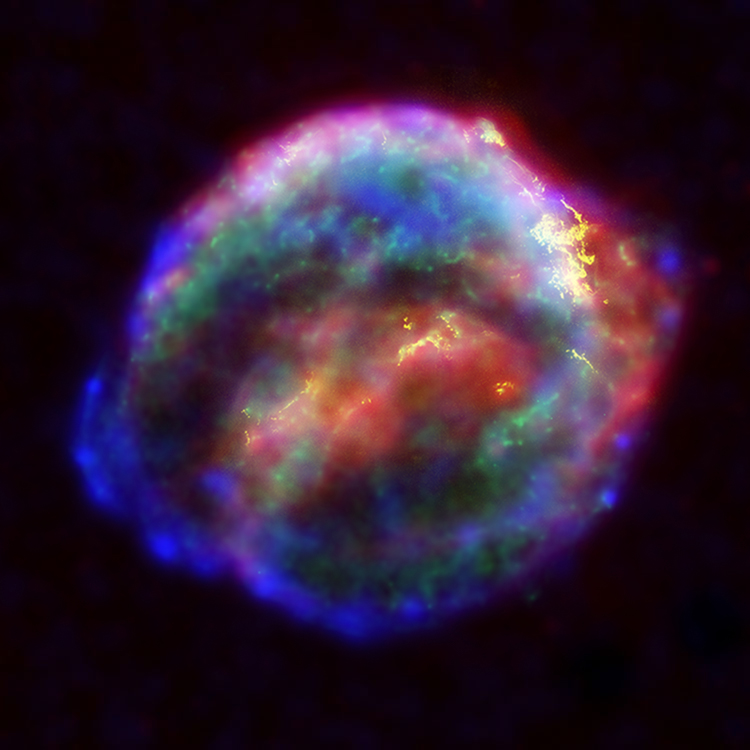Keplers supernova
X-ray, Optical & Infrared Composite of Kepler's Supernova Remnant
"On October 9, 1604, sky watchers -- including astronomer Johannes Kepler, spotted a "new star" in the western sky, rivaling the brilliance of nearby planets. "Kepler's supernova" was the last exploding supernova seen in our Milky Way galaxy. Observers used only their eyes to study it, because the telescope had not yet been invented. Now, astronomers have utilized NASA's three Great Observatories to analyze the supernova remnant in infrared, optical and X-ray light." [1]
- Color Code (Energy):
- Blue: X-ray (4-6 keV), en:Chandra X-ray Observatory, The higher-energy X-rays come primarily from the regions directly behind the shock front.
- Green: X-ray (0.3-1.4 keV), en:Chandra X-ray Observatory; Lower-energy X-rays mark the location of the hot remains of the exploded star.
- Yellow: Optical, en:Hubble Space Telescope; The optical image reveals 10,000 degrees Celsius gas where the supernova shock wave is slamming into the densest regions of surrounding gas.
- Red: Infrared, en:Spitzer space telescope; The infrared image highlights microscopic dust particles swept up and heated by the supernova shock wave.
Relevante Bilder










































Relevante Artikel
Supernova 1604Die Supernova 1604 (SN1604), auch Keplers Supernova oder Keplers Stern genannt, war eine galaktische Supernova, die im Jahr 1604 in etwa 6.000 Parsec Entfernung im Sternbild Schlangenträger (Ophiuchus) erschien. Mit einer scheinbaren Helligkeit von −2,5 mag war sie der hellste Stern am Nachthimmel. Sie war die bislang letzte Supernova, die in der Milchstraße beim Ausbruch beobachtet wurde. Es handelte sich dabei um eine thermonukleare Supernova vom Typ Ia. .. weiterlesen
Johannes KeplerJohannes Kepler, auch Johannes Keppler oder Johann Kepler, auch latinisiert Ioannes Keplerus oder Johannes Keplerus, war ein deutscher Astronom, Physiker, Mathematiker und Naturphilosoph. Er war von 1594 bis 1600 im Alter von 23 Jahren in der Steiermark im Auftrag der steirischen Landstände als Lehrer für Mathematik in Graz tätig, wo er auch schon mit eigenen wissenschaftlichen Arbeiten begann. In Graz heiratete Kepler 1597 seine erste Ehefrau Barbara Müller. Mit Beginn der Gegenreformation in Graz musste das protestantische Ehepaar im August 1600 die Stadt verlassen und zog nach Prag. .. weiterlesen
9. OktoberDer 9. Oktober ist der 282. Tag des gregorianischen Kalenders, somit bleiben 83 Tage bis zum Jahresende. .. weiterlesen
